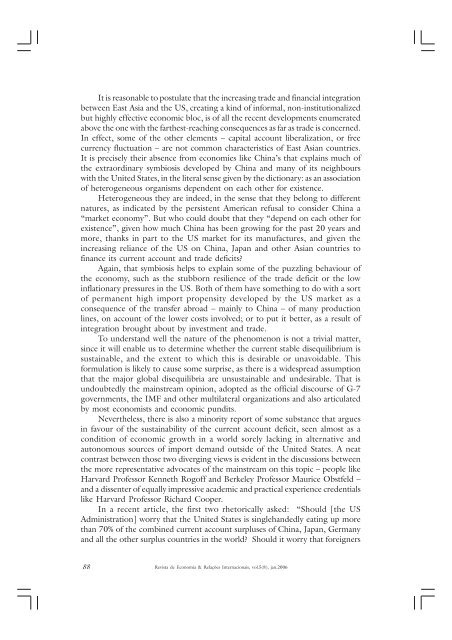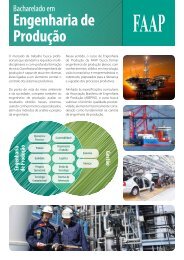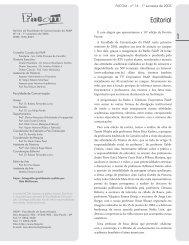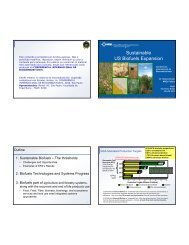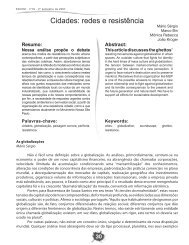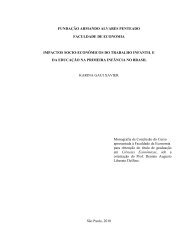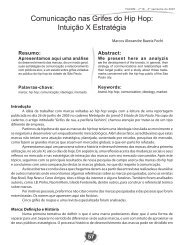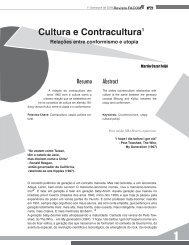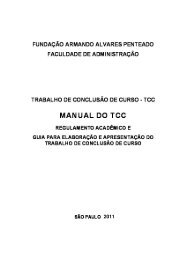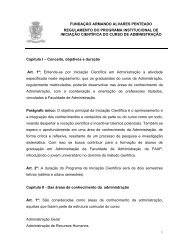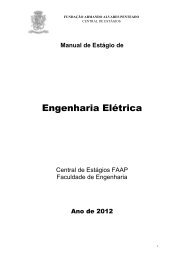Número 8 - Janeiro 2006 - Faap
Número 8 - Janeiro 2006 - Faap
Número 8 - Janeiro 2006 - Faap
You also want an ePaper? Increase the reach of your titles
YUMPU automatically turns print PDFs into web optimized ePapers that Google loves.
It is reasonable to postulate that the increasing trade and financial integration<br />
between East Asia and the US, creating a kind of informal, non-institutionalized<br />
but highly effective economic bloc, is of all the recent developments enumerated<br />
above the one with the farthest-reaching consequences as far as trade is concerned.<br />
In effect, some of the other elements – capital account liberalization, or free<br />
currency fluctuation – are not common characteristics of East Asian countries.<br />
It is precisely their absence from economies like China’s that explains much of<br />
the extraordinary symbiosis developed by China and many of its neighbours<br />
with the United States, in the literal sense given by the dictionary: as an association<br />
of heterogeneous organisms dependent on each other for existence.<br />
Heterogeneous they are indeed, in the sense that they belong to different<br />
natures, as indicated by the persistent American refusal to consider China a<br />
“market economy”. But who could doubt that they “depend on each other for<br />
existence”, given how much China has been growing for the past 20 years and<br />
more, thanks in part to the US market for its manufactures, and given the<br />
increasing reliance of the US on China, Japan and other Asian countries to<br />
finance its current account and trade deficits?<br />
Again, that symbiosis helps to explain some of the puzzling behaviour of<br />
the economy, such as the stubborn resilience of the trade deficit or the low<br />
inflationary pressures in the US. Both of them have something to do with a sort<br />
of permanent high import propensity developed by the US market as a<br />
consequence of the transfer abroad – mainly to China – of many production<br />
lines, on account of the lower costs involved; or to put it better, as a result of<br />
integration brought about by investment and trade.<br />
To understand well the nature of the phenomenon is not a trivial matter,<br />
since it will enable us to determine whether the current stable disequilibrium is<br />
sustainable, and the extent to which this is desirable or unavoidable. This<br />
formulation is likely to cause some surprise, as there is a widespread assumption<br />
that the major global disequilibria are unsustainable and undesirable. That is<br />
undoubtedly the mainstream opinion, adopted as the official discourse of G-7<br />
governments, the IMF and other multilateral organizations and also articulated<br />
by most economists and economic pundits.<br />
Nevertheless, there is also a minority report of some substance that argues<br />
in favour of the sustainability of the current account deficit, seen almost as a<br />
condition of economic growth in a world sorely lacking in alternative and<br />
autonomous sources of import demand outside of the United States. A neat<br />
contrast between those two diverging views is evident in the discussions between<br />
the more representative advocates of the mainstream on this topic – people like<br />
Harvard Professor Kenneth Rogoff and Berkeley Professor Maurice Obstfeld –<br />
and a dissenter of equally impressive academic and practical experience credentials<br />
like Harvard Professor Richard Cooper.<br />
In a recent article, the first two rhetorically asked: “Should [the US<br />
Administration] worry that the United States is singlehandedly eating up more<br />
than 70% of the combined current account surpluses of China, Japan, Germany<br />
and all the other surplus countries in the world? Should it worry that foreigners<br />
88 Revista de Economia & Relações Internacionais, vol.5(8), jan.<strong>2006</strong>


